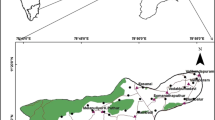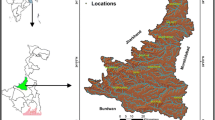Abstract
The development of groundwater resources has been challenged due to an increase in water demand. An irregular climate and overpopulation have contributed to the groundwater crisis in recent years, resulting in overexploitation and overstressed aquifers. This work was carried out in the hard rock terrain of Madurai district, Tamil Nadu, India. The purpose of this study is to identify suitable groundwater recharge zones to satisfy this region's water resource demand. Each feature's weighting and ranking were calculated using the multi-influencing factor method and literature review. A number of thematic maps were prepared with ArcGIS software as part of this study. Groundwater potential zone is delineated by seven influencing factors including geology, geomorphology, soil, land use/land cover, slope, lineament and drainage density. In this study, groundwater potential maps were obtained using GIS and remote sensing techniques by weighted overlay analysis. Groundwater potential is influenced by land use, geomorphology and geology. According to results, groundwater potential zones were found to be covering this region in increasing order such as high groundwater potential, low groundwater potential, and medium groundwater potential. With the help of groundwater level data, a groundwater potential zone was validated. In the future, it will be very useful to identify new locations for good groundwater resources as well as to manage water resources sustainably.








Similar content being viewed by others
Data availability
The datasets or analyzed during this study are available from the corresponding author on reasonable request.
References
Abijith D, Saravanan S, Singh L, Jennifer J, Saranya T, Parthasarathy K (2020) GIS-based multi-criteria analysis for identification of potential groundwater recharge zones – a case study from Ponnaiyary watershed, Tamil Nadu, India. HydroResearch 3:1–14. https://doi.org/10.1016/j.hydres.2020.02.002
Achu AL, Reghunath R, Thomas J (2019) Mapping of groundwater recharge potential zones and identification of suitable site-specific recharge mechanisms in a tropical river basin. Earth Syst Environ 4:131–145. https://doi.org/10.1007/s41748-019-00138-5
Anbarasu S, Brindha K, Elango L (2020) Multi-influencing factor method for delineation of groundwater potential zones using remote sensing and GIS techniques in the western part of Perambalur district, southern India. Earth Sci Inform 13(2):317–332. https://doi.org/10.1007/s12145-019-00426-8
Anbarasu S, Brindha K, Elango L (2022) Geochemical evolution of fluoride and groundwater quality for drinking and irrigation purposes in a weathered gneissic rock aquifer of southern penisular India. Environ Earth Sci 81:273. https://doi.org/10.1007/s12665-022-10395-9
Anbazhagan S, Jothibasu A (2016) Geoinformatics in groundwater potential mapping and sustainable development: a case study from southern India. Hydrol Sci J 61:1109–1123. https://doi.org/10.1080/02626667.2014.990966
Andualem TG, Demeke GG (2019) Groundwater potential assessment using GIS and remote sensing: a case study of Guna tana landscape, upper blue Nile Basin, Ethiopia. J Hydrol Region Stud 24:100610. https://doi.org/10.1016/j.ejrh.2019.100610
Aouragh MH, Essahlaoui A, El Ouali A, El Hmaidi A, Kamel S (2017) Groundwater potential of Middle Atlas plateaus, Morocco, using fuzzy logic approach, GIS and remote sensing. Geomat Nat Hazards Risk 8:194–206. https://doi.org/10.1080/19475705.2016.1181676
Babatunde JF (2018) Integrating GIS and multi-influencing factor technique for delineation of potential groundwater recharge zones in parts of llesha schist belt, southwestern Nigeria. Environ Earth Sci 77:69. https://doi.org/10.1007/s12665-018-7229-5
Barua S, Mukhopadhyay BP, Bera A (2021) Integrated assessment of groundwater potential zone under agricultural dominated areas in the western part of Dakshin Dinajpur district, West Bengal, India. Arab J Geosci 14:1042. https://doi.org/10.1007/s12517-021-07312-y
CGWB (2007) District Ground Water Brochure, Madurai District, Tamil Nadu. Central Ground Water Board, Ministry of Water Resources, Government of India, Faridabad
Das N, Mukhopadhyay S (2018) Application of multi-criteria decision making technique for the assessment of groundwater potential zones: a study on Birbhum district, West Bengal, India. Environ Dev Sustain. https://doi.org/10.1007/s10668-018-0227-7
Duan H, Deng Z, Deng F, Wang D (2016) Assessment of groundwater potential based on multicriteria decision making model and decision tree algorithms. Math Probl Eng. https://doi.org/10.1155/2016/2064575
Fagbohun BJ (2018) Integrating GIS and multi-influencing factor technique for delineation of potential groundwater recharge zones in parts of Ilesha schist belt, southwestern Nigeria. Environ Earth Sci. https://doi.org/10.1007/s12665-018-7229-5
Falah F, Ghorbani Nejad S, Rahmati O, Daneshfar M, Zeinivand H (2017) Applicability of generalized additive model in groundwater potential modelling and comparison its performance by bivariate statistical methods. Geocarto Int 32:1069–1089. https://doi.org/10.1080/10106049.2016.1188166
GEC (2015) Report of the Ground Water Resource Estimation Committee (GEC 2015). Ministry of Water Resources, River Development & Ganga Rejuvenation, Government of India, Faridabad
Ghorbani Nejad S, Falah F, Daneshfar M, Haghizadeh A, Rahmati O (2017) Delineation of groundwater potential zones using remote sensing and GIS-based data-driven models. Geocarto Int 32:167–187. https://doi.org/10.1080/10106049.2015.1132481
Gnanachandrasamy G, Zhou Y, Bhagyaraj M, Venkatramanan S, Ramkumar T, Wang S (2018) Remote sensing and GIS based groundwater potential zone mapping in Ariyalur District, Tamil Nadu. J Geol Soc India 92:484–490. https://doi.org/10.1007/s12594-018-1046-z
Golkarian A, Naghibi SA, Kalantar B, Pradhan B (2018) Groundwater potential mapping using C5.0, random forest, and multivariate adaptive regression spline models in GIS. Environ Monit Assess. https://doi.org/10.1007/s10661-018-6507-8
Gopinath G, Swetha TV, Thrivikramji KP, Jesiya NP (2017) Geospatial and MCDM tool mix for identification of potential groundwater prospects in a tropical river basin, Kerala. Environ Earth Sci 76:428. https://doi.org/10.1007/s12665-017-6749-8
GSI (Geological Survey of India) (1995) Geology map of Madurai district, Tamil Nadu, India
Jasmin I, Mallikarjuna P (2011) Review: Satellite-based remote sensing and geographic information systems and their application in the assessment of groundwater potential, with particular reference to India. Hydrogeol J 19:729–740
Jha MK, Chowdhury A, Chowdary VM, Peiffer S (2007) Groundwater management and development by integrated remote sensing and geographic information systems: prospects and constraints. Water Resour Manag 21:427–467. https://doi.org/10.1007/s11269-006-9024-4
Jha MK, Chowdary VM, Chowdhury A (2010) Groundwater assessment in Salboni Block, West Bengal (India) using remote sensing, geographical information system and multi-criteria decision analysis techniques. Hydrogeol J 18:1713–1728. https://doi.org/10.1007/s10040-010-0631-z
Kanagaraj G, Suganthi S, Elango L, Mahesh NS (2018) Assessment of groundwater potential zones in Vellore district, Tamil Nadu, India using geospatial techniques. Earth Sci Inform 12(2):211–223. https://doi.org/10.1007/s12145-018-0363-5
Lee S, Hong S-M, Jung H-S (2018) GIS-based groundwater potential mapping using artificial neural network and support vector machine models: the case of Boryeong city in Korea. Geocarto Int 33:847–861. https://doi.org/10.1080/10106049.2017.1303091
Lee S, Kim Y, Joo OhH (2012) Application of a weights of evidence method and GIS to regional groundwater productivity potential mapping. J Environ Manage 96(1):91–105. https://doi.org/10.1016/j.jenvman.2011.09.016
Mahato S, Pal S (2018) Groundwater potential mapping in a rural river basin by union (OR) and intersection (AND) of four multi-criteria decision-making models. Nat Resour Res 28:523–545. https://doi.org/10.1007/s11053-018-9404-5
Mahesh NS, Chandrasekar N, Soundranayagam JP (2012) Delineation of groundwater potential zones in Theni district, Tamil Nadu, using remote sensing, GIS and MIF techniques. Geosci Front 3(2):189–196
Mohamed MM, Elmahdy SI (2017) Fuzzy logic and multi-criteria methods for groundwater potentiality mapping at Al Fo’ah area, the United Arab Emirates (UAE): an integrated approach. Geocarto Int 32:1120–1138. https://doi.org/10.1080/10106049.2016.1195884
Muhamad JN, Sardar K, Hasham Z, Amirzeb K (2018) Delineation of groundwater potential zones using GIS and multi influence factor (MIF) techniques: a study of district Swat, Khyber Pakhtunkhwa, Pakistan. Environ Earth Sci 77:367. https://doi.org/10.1007/s12665-018-7522-3
Murmu P, Kumar M, Lal D, Sonker I, Singh SK (2019) Delineation of groundwater potential zones using geospatial techniques and analytical hierarchy process in Dumka district, Jharkhand, India. Groundw Sustain Dev 9:100239. https://doi.org/10.1016/j.gsd.2019.100239
Naghibi SA, Pourghasemi HR, Pourtaghi ZS, Rezaei A (2015) Groundwater potential mapping using frequency ratio and Shannon’s entropy models in the Moghan watershed, Iran. Earth Sci India 8:171–186. https://doi.org/10.1007/s12145-014-0145-7
Oh H-J, Kim Y-S, Choi J-K, Park E, Lee S (2011) GIS mapping of regional probabilistic groundwater potential in the area of Pohang City, Korea. J Hydrol 399:158–172. https://doi.org/10.1016/j.jhydrol.2010.12.027
Oladunjoye MA, Adefehinti A, Ganiyu KAO (2019) Geophysical appraisal of groundwater potential in the crystalline rock of Kishi area, Southwestern Nigeria. J Afr Earth Sci 151:107–120. https://doi.org/10.1016/j.jafrearsci.2018.11.017
Pourghasemi HR, Beheshtirad M (2015) Assessment of a data-driven evidential belief function model and GIS for groundwater potential mapping in the Koohrang Watershed, Iran. Geocarto Int 30:662–685. https://doi.org/10.1080/10106049.2014.966161
Preeja KR, Joseph S, Thomas J, Vijith H (2011) Identification of groundwater potential zones of a Tropical River Basin (Kerala, India) using remote sensing and GIS techniques. J Indian Soc Remote Sens 39:83–94. https://doi.org/10.1007/s12524-011-0075-5
Rahmati O, Pourghasemi HR, Melesse AM (2016) Application of GIS-based data driven random forest and maximum entropy models for groundwater potential mapping: a case study at Mehran Region, Iran. CATENA 137:360–372. https://doi.org/10.1016/j.catena.2015.10.010
Rajaveni SP, Brindha K, Rajesh R, Elango L (2013) Spatial and temporal variation of groundwater level and its relation to drainage and intrusive rocks in a part of Nalgonda district, Andhra Pradesh, India. J Indian Soc Remote Sens 42:765–776. https://doi.org/10.1007/s12524-013-0328-6
Rajaveni SP, Brindha K, Elango L (2015) Geological and geomorphological controls on groundwater occurrence in a hard rock region. Appl Water Sci 7:1377–1389. https://doi.org/10.1007/s13201-015-0327-6
Razandi Y, Pourghasemi HR, Neisani NS, Rahmati O (2015) Application of analytical hierarchy process, frequency ratio, and certainty factor models for groundwater potential mapping using GIS. Earth Sci Inf 8:867–883. https://doi.org/10.1007/s12145-015-0220-8
Senanayake IP, Dissanayake DMD, Mayadunna BB, Weerasekera WL (2016) An approach to delineate groundwater recharge potential sites in Ambalantota, Sri Lanka using GIS techniques. Geosci Front 7:115–124. https://doi.org/10.1016/j.gsf.2015.03.002
Senapathi U, Kumar Das T (2022) GIS-based comparative assessment of groundwater potential zone using MIF and AHP techniques in Cooch Behar district, west Bengal. Appl Water Sci 12:43. https://doi.org/10.1007/s13201-021-01509-y
Silwal CB, Pathak D (2018) Review on practices and state of the art methods on delineation of groundwater potential using GIS and remote sensing. Bull Dep Geol 20:7–20. https://doi.org/10.3126/bdg.v20i0.20717
Suganthi S, Elango L, Subramanian SK (2014) Groundwater potential zonation by remote sensing and GIS techniques and its relation to the Groundwater level in the coastal part of the Arani and Koratalai River Basin, Southern India. Earth Sci Res J 17:87–95
TWAD (2018) Perambalur District Profile, Tamil Nadu Water Supply and Drainage Board. Available from https://www.twadboard.tn.gov.in/content/Madurai-district. Accessed on 4th May 2022
UNWWAP (2015) United Nations World Water Assessment Programme 2015: water for a sustainable world
Yadav MS, Kanga S, Singh SK (2019) Groundwater prospect zonation using frequency ratio model for Banganga River Basin, India. Int J Eng Adv Technol 8:806–814. https://doi.org/10.35940/ijeat.F8019.088619
Acknowledgements
The authors would like to thank reviewers for valuable comments and development of the manuscript.
Funding
The authors declare that no funds or grants are received during preparation of this manuscript.
Author information
Authors and Affiliations
Contributions
GS initiated manuscript, SA revised full manuscript and prepared maps, GS collected samples and analysed. GS and SA corrected manuscript, read full manuscript and finally submitted.
Corresponding author
Ethics declarations
Conflict of interest
The authors declare that they have no known competing financial interest.
Additional information
Publisher's Note
Springer Nature remains neutral with regard to jurisdictional claims in published maps and institutional affiliations.
Rights and permissions
Springer Nature or its licensor (e.g. a society or other partner) holds exclusive rights to this article under a publishing agreement with the author(s) or other rightsholder(s); author self-archiving of the accepted manuscript version of this article is solely governed by the terms of such publishing agreement and applicable law.
About this article
Cite this article
Ganesan, S., Subramaniyan, A. Identification of groundwater potential zones using multi-influencing factor method, GIS and remote sensing techniques in the hard rock terrain of Madurai district, southern India. Sustain. Water Resour. Manag. 10, 54 (2024). https://doi.org/10.1007/s40899-024-01036-z
Received:
Accepted:
Published:
DOI: https://doi.org/10.1007/s40899-024-01036-z




